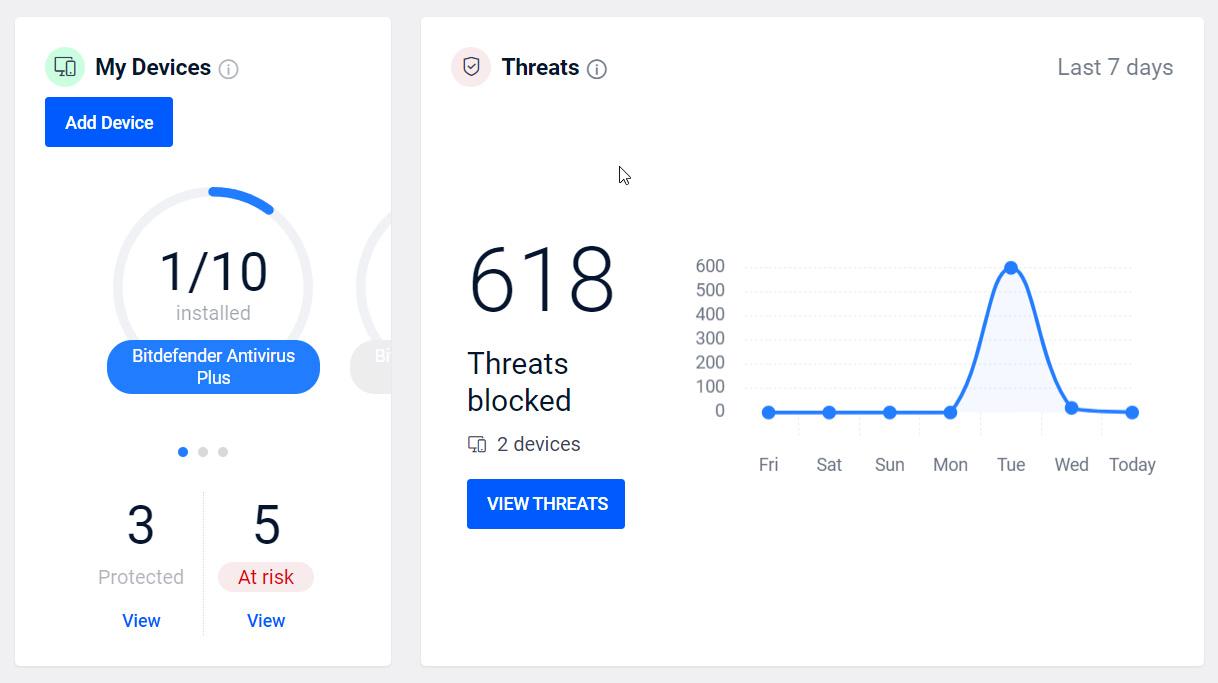Future-proof your business with tailored Infrastructure-as-a-Service solutions
Bitdefender Endpoint Protection provides robust protection against ransomware attacks, phishing and web threats
Designed to minimize risks for remote workers, Endpoint Security leverages mature AI, advanced risk analytics, content and device control, network defense and exploit defense to strengthen security across all servers, workstations and more
Plans & Pricing
Plan includes
Risk Analytics
Find and fix vulnerabilities, track & improve risk scores
Anti-exploit
Detects exploit techniques, stops 0-day exploits
Firewall
Two-way host firewall protecting endpoints anywhere
Web Threat Protection
Behavioral traffic scan, Anti-phishing, Search Advisor
Content & Device Control
Restrict user access to applications, sites, or web categories. Control access & use of external devices
Behaviour monitoring
0-Trust process monitor, automatically blocks malicious processes
Network Attack Defense
Blocks network-based attacks such as Brute Force or Password Stealers
Ransomware Mitigation
Restore files after ransomware attacks from secure copies
Nothing comes close to Bitdefender
Powerful but light
Proven to have the lowest system impact, Bitdefender always scores best on independent tests for protection and performance
One suite to do it all
Bitdefender is both antivirus and antimalware, so you only need one cyber security solution. You can further enhance its powerful base functions with add-ons
Easy deployment
No security server needed. Bitdefender automatically uninstalls competing endpoint solutions and provides a mass remote deployment mechanism for fast and simple rollout


Support that puts you in control of your business 24 hours a day, 7 days a week
Best-in-class 24/7 technical support as standard for all subscriptions under your account
- Free Migration & Onboarding
- 24*7 Support Availability
- Multiple Support Channels
- Unlimited Support Requests
- Self Service Platform
- Measured Response Time
- Priority Support Add-on
- Enterprise Support Add-on
Become our Partner
More than 1,000+ resellers, integrators, administrators, consultants & affiliates leverage our 20+ years of expertise, deep portfolio and preferential pricing to deliver high-value solutions to their customers
10,000+ happy customers trust us
#1 Bitdefender Antivirus provider | Best Bitdefender Antivirus | Cheap Bitdefender Antivirus | Top Bitdefender Antivirus | Bitdefender Antivirus Best Deal
Proactive Bitdefender Protection against Ransomware Attack in Dubai, UAE
Protecting against ransomware requires a combination of proactive measures and a robust security strategy. Bitdefender, a reputable cybersecurity solution, offers various features that can help defend against ransomware attacks. Here are some proactive steps you can take using Bitdefender:
- Install and Update Bitdefender: Ensure that Bitdefender is installed on all devices in your network, including computers, servers, and mobile devices. Regularly update the software to benefit from the latest security patches and features.
- Real-Time Protection: Activate Bitdefender's real-time protection feature, which constantly monitors files, applications, and network activity to identify and block potential threats, including ransomware.
- Behavioral Analysis: Bitdefender uses behavioral analysis to detect suspicious activities that may indicate ransomware behavior. This proactive approach helps identify and stop threats before they can cause damage.
- Advanced Threat Defense: Utilize Bitdefender's advanced threat defense capabilities, which can identify and block sophisticated attacks, including those using ransomware. This feature is designed to analyze the behavior of applications in real-time and stop malicious activities.
- Vulnerability Assessment: Regularly scan your systems for vulnerabilities using Bitdefender's vulnerability assessment tools. Addressing vulnerabilities promptly can prevent ransomware from exploiting weaknesses in your system.
- Safe Files: Bitdefender's Safe Files feature allows you to designate certain files and folders as "protected." This helps prevent unauthorized changes and access, offering an additional layer of defense against ransomware.
- Web Protection: Enable Bitdefender's web protection features to block access to malicious websites and prevent users from inadvertently downloading ransomware or other threats.
- Email Security: Ransomware often spreads through phishing emails. Bitdefender's email security features can help filter out malicious emails and attachments, reducing the risk of infection.
- Regular Backups: While not specific to Bitdefender, maintaining regular backups of your important data is crucial. In the event of a ransomware attack, you can restore your systems and files without having to pay a ransom.
- Employee Training: Educate your employees about the risks of ransomware and the importance of following security protocols. Train them to recognize phishing attempts and avoid clicking on suspicious links or downloading unknown attachments.
- Network Security: Ensure that your network is properly secured. This includes implementing firewalls, intrusion detection/prevention systems, and secure Wi-Fi protocols.
- Incident Response Plan: Develop and regularly update an incident response plan. This plan should outline the steps to take in the event of a ransomware attack, including communication protocols, isolation procedures, and recovery processes.
By implementing these proactive measures and staying informed about the latest security threats, you can enhance your organization's resilience against ransomware attacks in Dubai, UAE, or any other location. Keep in mind that cybersecurity is an ongoing process, and regular updates and improvements to your security strategy are essential.
What is Ransomware? Prevention & Data Recovery
Ransomware is a type of malicious software (malware) designed to block access to a computer system or files until a sum of money, or ransom, is paid to the attacker. This form of cyberattack has become increasingly prevalent and can have severe consequences for individuals and organizations.
Prevention of Ransomware:
- Backup Regularly:
- Ensure regular backup of your important files and data. Use external hard drives or cloud storage for backups.
- Disconnect the backup device after the backup is complete to prevent it from being compromised. - Update Software: Keep your operating system, antivirus software, and all other applications up to date. Security patches are often released to address vulnerabilities.
- Use Antivirus and Anti-Malware Software: Install reputable antivirus and anti-malware software and keep it updated. Regularly scan your system for potential threats.
- Beware of Email Phishing: Be cautious when opening emails, especially from unknown senders. Avoid clicking on links or downloading attachments from suspicious emails.
- Use a Firewall: Enable a firewall to monitor and control incoming and outgoing network traffic, providing an additional layer of security.
- Employee Training: Educate employees about the dangers of phishing emails and the importance of cybersecurity best practices.
- Limit User Privileges: Restrict user privileges to the minimum necessary for their job functions. This can minimize the potential impact of a ransomware attack.
- Network Segmentation: Segment your network to contain and isolate any potential infections, preventing the spread of malware.
Data Recovery from Ransomware:
- Restore from Backup: If you have a recent backup, restore your system and files from that backup. Ensure the backup was created before the ransomware infection occurred.
- Check for Decryption Tools: Some cybersecurity organizations and law enforcement agencies release free decryption tools for certain types of ransomware. Check for the availability of such tools online.
- Consult with Security Experts: Seek help from cybersecurity professionals or specialized companies that may have experience in dealing with ransomware. They may be able to assist in decrypting your files.
- Do Not Pay the Ransom: It's generally not recommended to pay the ransom. Paying does not guarantee that you will get your files back, and it encourages cybercriminals to continue their activities.
- Report the Incident: Report the ransomware attack to law enforcement agencies. This can contribute to ongoing investigations and may help prevent future attacks.
Remember that prevention is key when it comes to ransomware. Regularly updating your security measures and staying vigilant against potential threats can significantly reduce the risk of falling victim to a ransomware attack.
 Get Customized Solution
Get Customized Solution